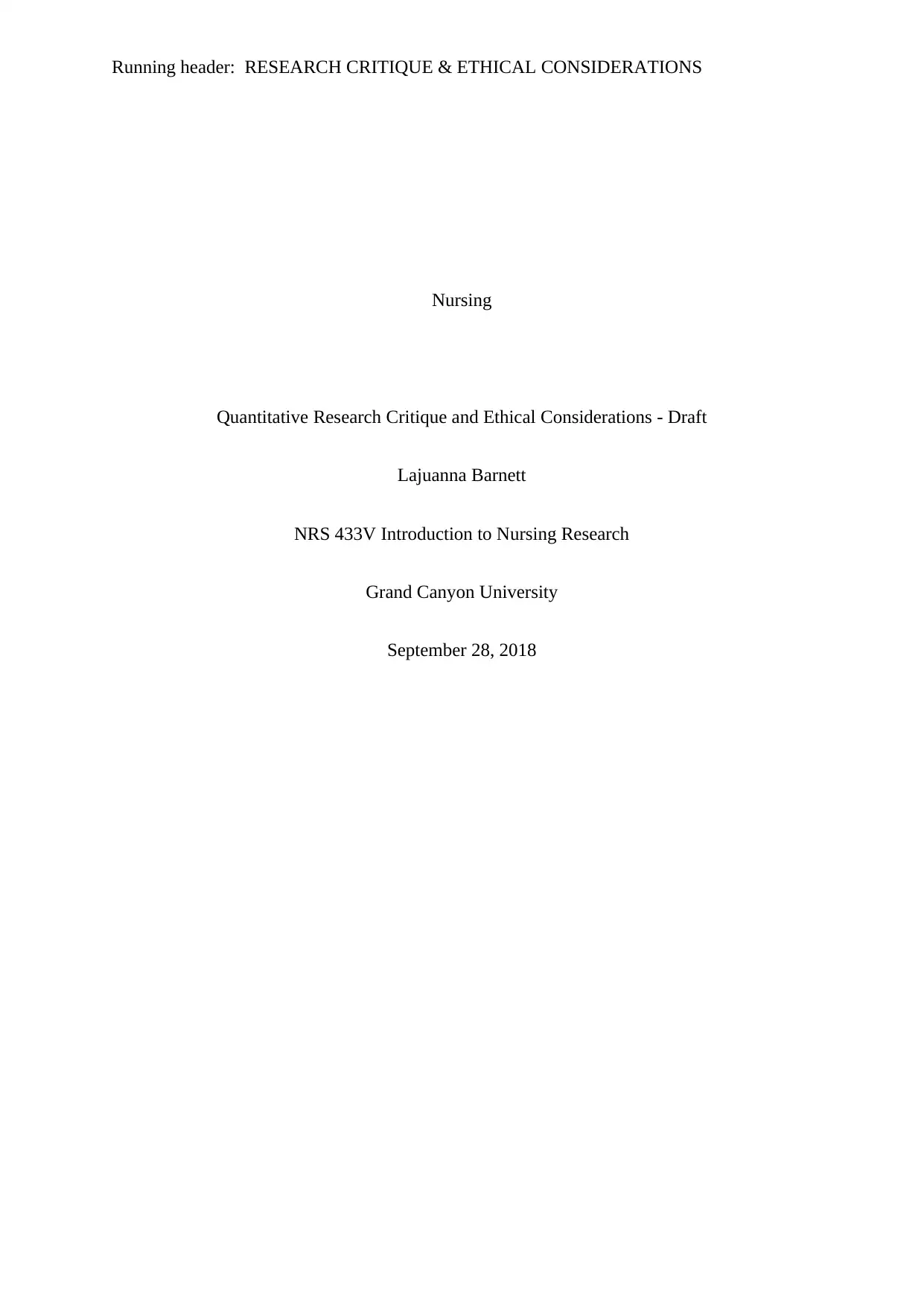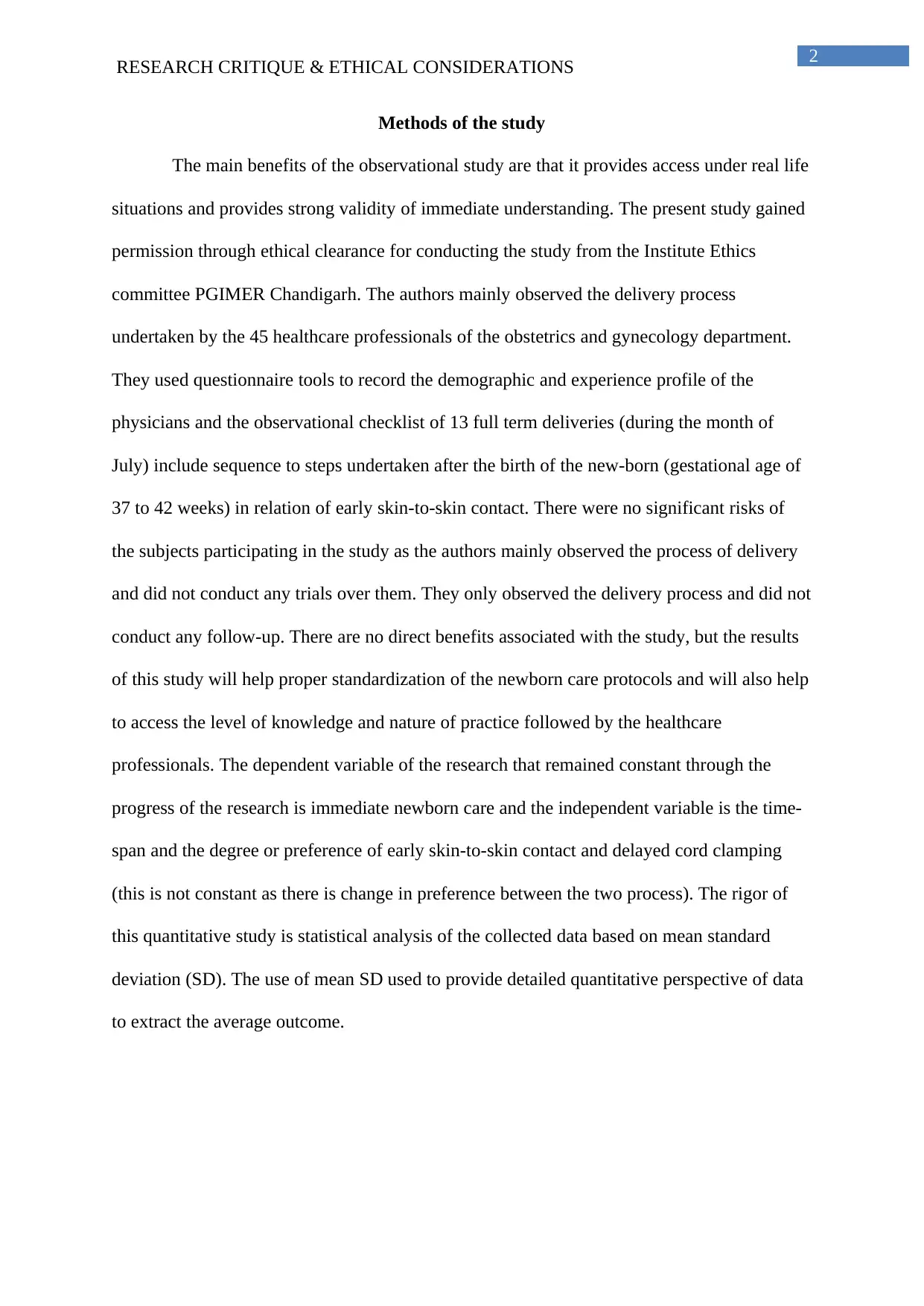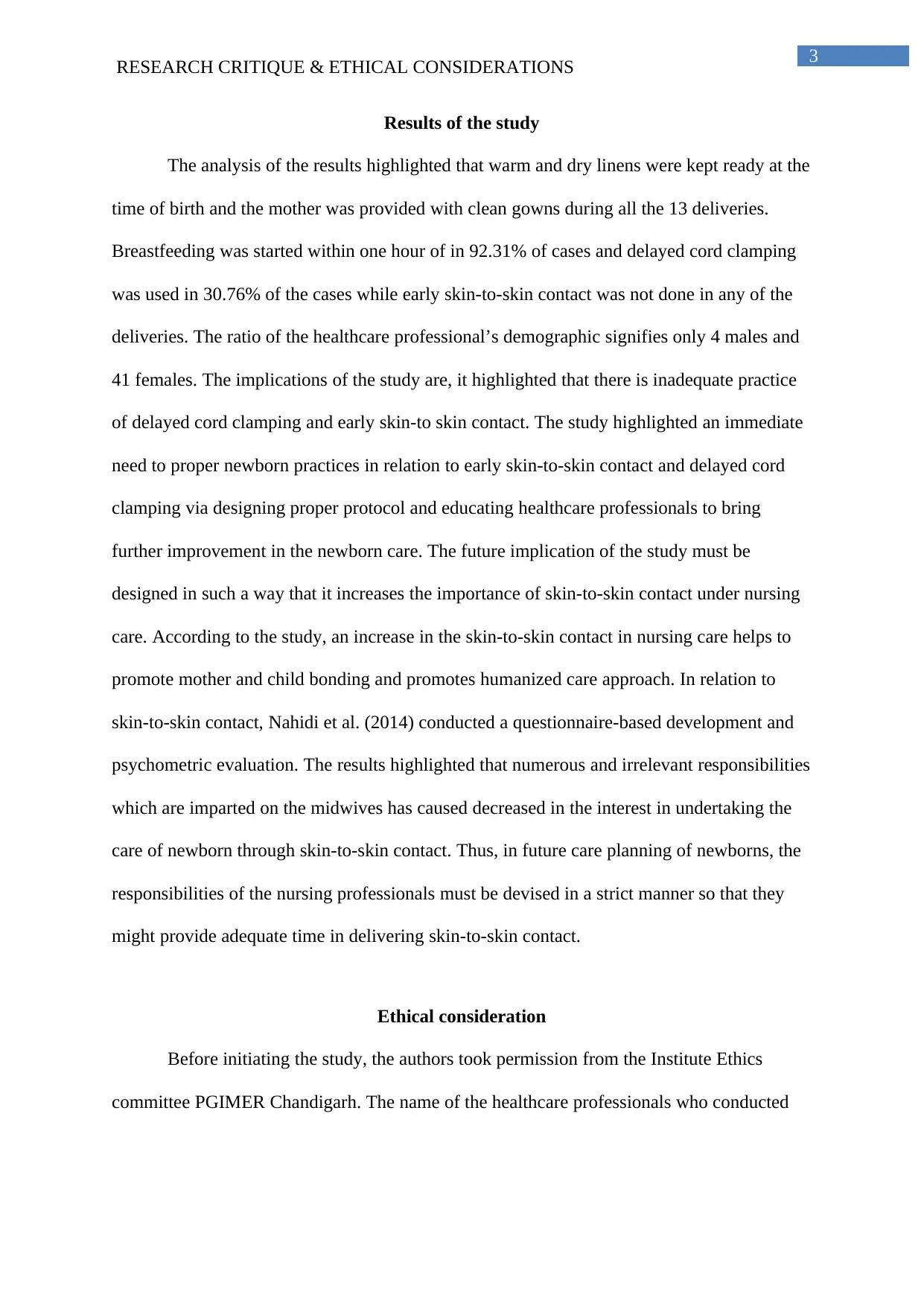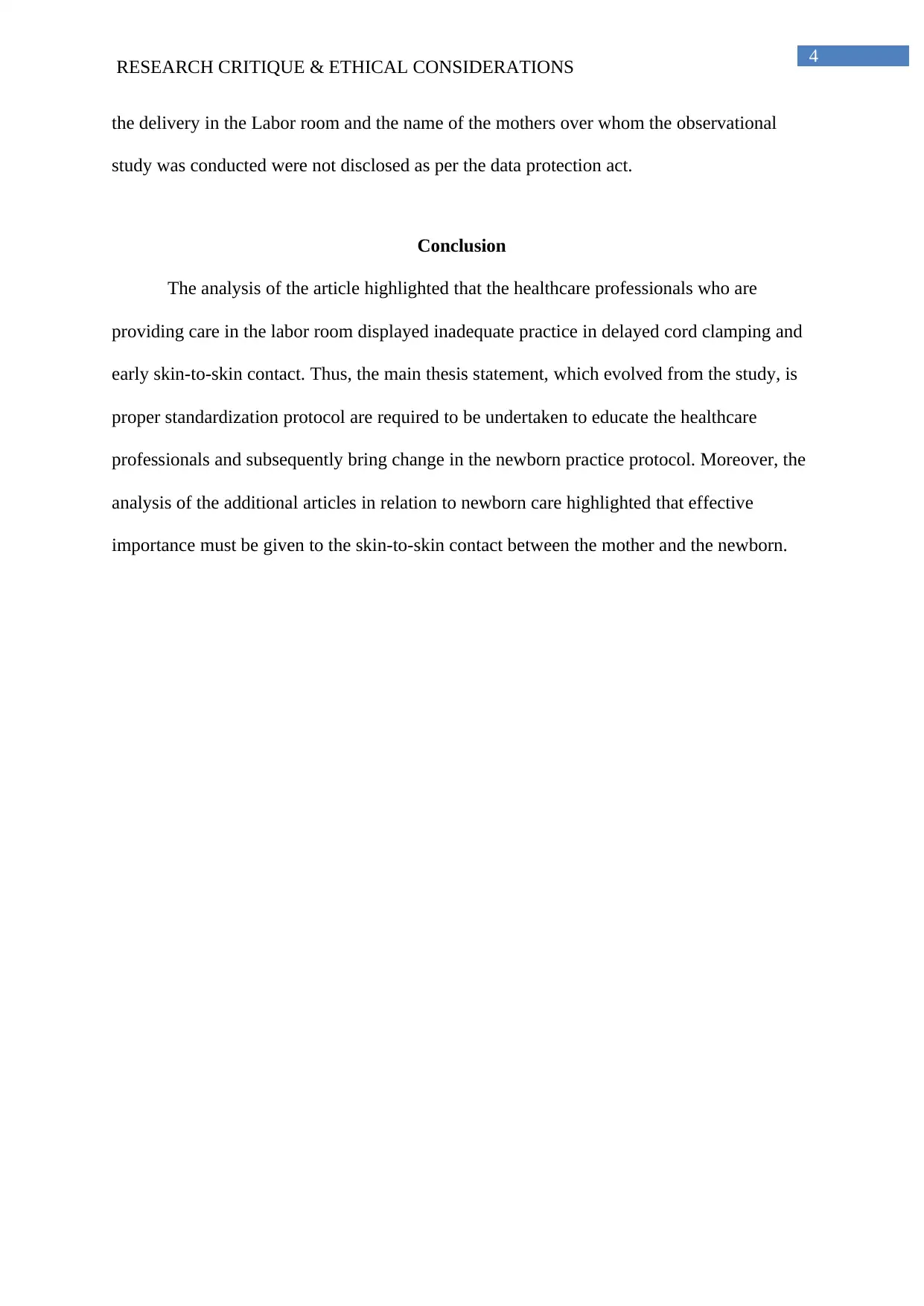Research Critique of Newborn Care Practices: Ethical Considerations
VerifiedAdded on 2023/06/03
|7
|1409
|330
Report
AI Summary
This report presents a research critique of a quantitative study examining newborn care practices, specifically focusing on early skin-to-skin contact and delayed cord clamping among healthcare professionals. The study, conducted in a tertiary care hospital in North India, aimed to assess current practices and their correlation. The critique analyzes the study's methods, including the observational design, ethical considerations, and data analysis. The results revealed inadequate implementation of delayed cord clamping and early skin-to-skin contact. The report also discusses the implications of the study, emphasizing the need for standardized protocols and education for healthcare professionals to improve newborn care. The ethical aspects, including data protection, are also evaluated, along with references to supporting research. The overall conclusion stresses the importance of promoting skin-to-skin contact and humanized care approaches in newborn care practices.

Running header: RESEARCH CRITIQUE & ETHICAL CONSIDERATIONS
Nursing
Quantitative Research Critique and Ethical Considerations - Draft
Lajuanna Barnett
NRS 433V Introduction to Nursing Research
Grand Canyon University
September 28, 2018
Nursing
Quantitative Research Critique and Ethical Considerations - Draft
Lajuanna Barnett
NRS 433V Introduction to Nursing Research
Grand Canyon University
September 28, 2018
Paraphrase This Document
Need a fresh take? Get an instant paraphrase of this document with our AI Paraphraser

1
RESEARCH CRITIQUE & ETHICAL CONSIDERATIONS
Introduction
According to Kardefelt-Winther (2014), a research critique is a systematic way of
objectively reviewing a piece of research to highlight the strengths and weakness of the study
design and the applicability of the research into practice. The following assignment aims to
undertaken research critique of the paper named “A pilot study to assess the current practices
of immediate newborn care for term newborns in relation to early skin-to-skin contact and
delayed cord clamping among health personnel of Labour Room” published by Khyriem,
Venkadalakshmi and Rana in Nursing and Midwifery Research in the year 2017.
Background of the study
The clinical or the research problem that was highlighted in the study of Khyriem and
his fellow authors (2017) was: there are differences in the recommendation or regulations of
practice in the standards of newborn care. Thus, the main objective of the study was to assess
the current practices of the immediate newborn care for newborns in relation to early skin-to-
skin contact and delayed cord clamping among the health care professionals in the labor
room. They selected a tertiary care hospital in North India as the main center for the
conduction of the study. The main research question was to analyze the correlation between
cord clamping and skin-to-skin contact. The rationale of the objective selected by the authors
is assessment of the current practices by the healthcare professionals will help to determine
the relation to early skin-to skin contact and delayed cord clamping in immediate newborn
care. Knowing the relation will guide the future research prospects of standardization of
practice. The purpose of the research question is related to the problem of the study as it
mainly aims to establish the importance of skin-to-skin contact in the immediate newborn
care.
RESEARCH CRITIQUE & ETHICAL CONSIDERATIONS
Introduction
According to Kardefelt-Winther (2014), a research critique is a systematic way of
objectively reviewing a piece of research to highlight the strengths and weakness of the study
design and the applicability of the research into practice. The following assignment aims to
undertaken research critique of the paper named “A pilot study to assess the current practices
of immediate newborn care for term newborns in relation to early skin-to-skin contact and
delayed cord clamping among health personnel of Labour Room” published by Khyriem,
Venkadalakshmi and Rana in Nursing and Midwifery Research in the year 2017.
Background of the study
The clinical or the research problem that was highlighted in the study of Khyriem and
his fellow authors (2017) was: there are differences in the recommendation or regulations of
practice in the standards of newborn care. Thus, the main objective of the study was to assess
the current practices of the immediate newborn care for newborns in relation to early skin-to-
skin contact and delayed cord clamping among the health care professionals in the labor
room. They selected a tertiary care hospital in North India as the main center for the
conduction of the study. The main research question was to analyze the correlation between
cord clamping and skin-to-skin contact. The rationale of the objective selected by the authors
is assessment of the current practices by the healthcare professionals will help to determine
the relation to early skin-to skin contact and delayed cord clamping in immediate newborn
care. Knowing the relation will guide the future research prospects of standardization of
practice. The purpose of the research question is related to the problem of the study as it
mainly aims to establish the importance of skin-to-skin contact in the immediate newborn
care.

2
RESEARCH CRITIQUE & ETHICAL CONSIDERATIONS
Methods of the study
The main benefits of the observational study are that it provides access under real life
situations and provides strong validity of immediate understanding. The present study gained
permission through ethical clearance for conducting the study from the Institute Ethics
committee PGIMER Chandigarh. The authors mainly observed the delivery process
undertaken by the 45 healthcare professionals of the obstetrics and gynecology department.
They used questionnaire tools to record the demographic and experience profile of the
physicians and the observational checklist of 13 full term deliveries (during the month of
July) include sequence to steps undertaken after the birth of the new-born (gestational age of
37 to 42 weeks) in relation of early skin-to-skin contact. There were no significant risks of
the subjects participating in the study as the authors mainly observed the process of delivery
and did not conduct any trials over them. They only observed the delivery process and did not
conduct any follow-up. There are no direct benefits associated with the study, but the results
of this study will help proper standardization of the newborn care protocols and will also help
to access the level of knowledge and nature of practice followed by the healthcare
professionals. The dependent variable of the research that remained constant through the
progress of the research is immediate newborn care and the independent variable is the time-
span and the degree or preference of early skin-to-skin contact and delayed cord clamping
(this is not constant as there is change in preference between the two process). The rigor of
this quantitative study is statistical analysis of the collected data based on mean standard
deviation (SD). The use of mean SD used to provide detailed quantitative perspective of data
to extract the average outcome.
RESEARCH CRITIQUE & ETHICAL CONSIDERATIONS
Methods of the study
The main benefits of the observational study are that it provides access under real life
situations and provides strong validity of immediate understanding. The present study gained
permission through ethical clearance for conducting the study from the Institute Ethics
committee PGIMER Chandigarh. The authors mainly observed the delivery process
undertaken by the 45 healthcare professionals of the obstetrics and gynecology department.
They used questionnaire tools to record the demographic and experience profile of the
physicians and the observational checklist of 13 full term deliveries (during the month of
July) include sequence to steps undertaken after the birth of the new-born (gestational age of
37 to 42 weeks) in relation of early skin-to-skin contact. There were no significant risks of
the subjects participating in the study as the authors mainly observed the process of delivery
and did not conduct any trials over them. They only observed the delivery process and did not
conduct any follow-up. There are no direct benefits associated with the study, but the results
of this study will help proper standardization of the newborn care protocols and will also help
to access the level of knowledge and nature of practice followed by the healthcare
professionals. The dependent variable of the research that remained constant through the
progress of the research is immediate newborn care and the independent variable is the time-
span and the degree or preference of early skin-to-skin contact and delayed cord clamping
(this is not constant as there is change in preference between the two process). The rigor of
this quantitative study is statistical analysis of the collected data based on mean standard
deviation (SD). The use of mean SD used to provide detailed quantitative perspective of data
to extract the average outcome.
⊘ This is a preview!⊘
Do you want full access?
Subscribe today to unlock all pages.

Trusted by 1+ million students worldwide

3
RESEARCH CRITIQUE & ETHICAL CONSIDERATIONS
Results of the study
The analysis of the results highlighted that warm and dry linens were kept ready at the
time of birth and the mother was provided with clean gowns during all the 13 deliveries.
Breastfeeding was started within one hour of in 92.31% of cases and delayed cord clamping
was used in 30.76% of the cases while early skin-to-skin contact was not done in any of the
deliveries. The ratio of the healthcare professional’s demographic signifies only 4 males and
41 females. The implications of the study are, it highlighted that there is inadequate practice
of delayed cord clamping and early skin-to skin contact. The study highlighted an immediate
need to proper newborn practices in relation to early skin-to-skin contact and delayed cord
clamping via designing proper protocol and educating healthcare professionals to bring
further improvement in the newborn care. The future implication of the study must be
designed in such a way that it increases the importance of skin-to-skin contact under nursing
care. According to the study, an increase in the skin-to-skin contact in nursing care helps to
promote mother and child bonding and promotes humanized care approach. In relation to
skin-to-skin contact, Nahidi et al. (2014) conducted a questionnaire-based development and
psychometric evaluation. The results highlighted that numerous and irrelevant responsibilities
which are imparted on the midwives has caused decreased in the interest in undertaking the
care of newborn through skin-to-skin contact. Thus, in future care planning of newborns, the
responsibilities of the nursing professionals must be devised in a strict manner so that they
might provide adequate time in delivering skin-to-skin contact.
Ethical consideration
Before initiating the study, the authors took permission from the Institute Ethics
committee PGIMER Chandigarh. The name of the healthcare professionals who conducted
RESEARCH CRITIQUE & ETHICAL CONSIDERATIONS
Results of the study
The analysis of the results highlighted that warm and dry linens were kept ready at the
time of birth and the mother was provided with clean gowns during all the 13 deliveries.
Breastfeeding was started within one hour of in 92.31% of cases and delayed cord clamping
was used in 30.76% of the cases while early skin-to-skin contact was not done in any of the
deliveries. The ratio of the healthcare professional’s demographic signifies only 4 males and
41 females. The implications of the study are, it highlighted that there is inadequate practice
of delayed cord clamping and early skin-to skin contact. The study highlighted an immediate
need to proper newborn practices in relation to early skin-to-skin contact and delayed cord
clamping via designing proper protocol and educating healthcare professionals to bring
further improvement in the newborn care. The future implication of the study must be
designed in such a way that it increases the importance of skin-to-skin contact under nursing
care. According to the study, an increase in the skin-to-skin contact in nursing care helps to
promote mother and child bonding and promotes humanized care approach. In relation to
skin-to-skin contact, Nahidi et al. (2014) conducted a questionnaire-based development and
psychometric evaluation. The results highlighted that numerous and irrelevant responsibilities
which are imparted on the midwives has caused decreased in the interest in undertaking the
care of newborn through skin-to-skin contact. Thus, in future care planning of newborns, the
responsibilities of the nursing professionals must be devised in a strict manner so that they
might provide adequate time in delivering skin-to-skin contact.
Ethical consideration
Before initiating the study, the authors took permission from the Institute Ethics
committee PGIMER Chandigarh. The name of the healthcare professionals who conducted
Paraphrase This Document
Need a fresh take? Get an instant paraphrase of this document with our AI Paraphraser

4
RESEARCH CRITIQUE & ETHICAL CONSIDERATIONS
the delivery in the Labor room and the name of the mothers over whom the observational
study was conducted were not disclosed as per the data protection act.
Conclusion
The analysis of the article highlighted that the healthcare professionals who are
providing care in the labor room displayed inadequate practice in delayed cord clamping and
early skin-to-skin contact. Thus, the main thesis statement, which evolved from the study, is
proper standardization protocol are required to be undertaken to educate the healthcare
professionals and subsequently bring change in the newborn practice protocol. Moreover, the
analysis of the additional articles in relation to newborn care highlighted that effective
importance must be given to the skin-to-skin contact between the mother and the newborn.
RESEARCH CRITIQUE & ETHICAL CONSIDERATIONS
the delivery in the Labor room and the name of the mothers over whom the observational
study was conducted were not disclosed as per the data protection act.
Conclusion
The analysis of the article highlighted that the healthcare professionals who are
providing care in the labor room displayed inadequate practice in delayed cord clamping and
early skin-to-skin contact. Thus, the main thesis statement, which evolved from the study, is
proper standardization protocol are required to be undertaken to educate the healthcare
professionals and subsequently bring change in the newborn practice protocol. Moreover, the
analysis of the additional articles in relation to newborn care highlighted that effective
importance must be given to the skin-to-skin contact between the mother and the newborn.

5
RESEARCH CRITIQUE & ETHICAL CONSIDERATIONS
References
Kardefelt-Winther, D. (2014). A conceptual and methodological critique of internet addiction
research: Towards a model of compensatory internet use. Computers in Human
Behavior, 31, 351-354. https://doi.org/10.1016/j.chb.2013.10.059
Khyriem, B., Venkadalakshmi, V., & Rana., A. (2017). A pilot study to assess the current
practices of immediate newborn care for term newborns in relation to early skin-to-
skin contact and delayed cord clamping among health personnel of Labour Room.
Nursing and Midwifery Research Journal. 13(3). 2017.
Koller Kologeski, T., Strapasson, M. R., Schneider, V., & Renosto, J. M. (2017). Skin To
Skin Contact Of The Newborn With Its Mother In The Perspective Of The
Multiprofessional Team. Journal of Nursing UFPE/Revista de Enfermagem
UFPE, 11(1). Retrieved from: https://web.a.ebscohost.com/abstract?
direct=true&profile=ehost&scope=site&authtype=crawler&jrnl=19818963&asa=Y&
AN=120615045&h=yVucDU6diI
%2bdQ0NiNwTplFXb82s5UBlC44kAKB8qEhyMwbK0U6VfuAhMMRMvc5pxF
%2bdTar49sxpHYuVZOI6%2b3w%3d
%3d&crl=c&resultNs=AdminWebAuth&resultLocal=ErrCrlNotAuth&crlhashurl=log
in.aspx%3fdirect%3dtrue%26profile%3dehost%26scope%3dsite%26authtype
%3dcrawler%26jrnl%3d19818963%26asa%3dY%26AN%3d120615045
Nahidi, F., Tavafian, S. S., Heidarzadeh, M., Hajizadeh, E., & Montazeri, A. (2014). The
Mother-Newborn Skin-to-Skin Contact Questionnaire (MSSCQ): development and
RESEARCH CRITIQUE & ETHICAL CONSIDERATIONS
References
Kardefelt-Winther, D. (2014). A conceptual and methodological critique of internet addiction
research: Towards a model of compensatory internet use. Computers in Human
Behavior, 31, 351-354. https://doi.org/10.1016/j.chb.2013.10.059
Khyriem, B., Venkadalakshmi, V., & Rana., A. (2017). A pilot study to assess the current
practices of immediate newborn care for term newborns in relation to early skin-to-
skin contact and delayed cord clamping among health personnel of Labour Room.
Nursing and Midwifery Research Journal. 13(3). 2017.
Koller Kologeski, T., Strapasson, M. R., Schneider, V., & Renosto, J. M. (2017). Skin To
Skin Contact Of The Newborn With Its Mother In The Perspective Of The
Multiprofessional Team. Journal of Nursing UFPE/Revista de Enfermagem
UFPE, 11(1). Retrieved from: https://web.a.ebscohost.com/abstract?
direct=true&profile=ehost&scope=site&authtype=crawler&jrnl=19818963&asa=Y&
AN=120615045&h=yVucDU6diI
%2bdQ0NiNwTplFXb82s5UBlC44kAKB8qEhyMwbK0U6VfuAhMMRMvc5pxF
%2bdTar49sxpHYuVZOI6%2b3w%3d
%3d&crl=c&resultNs=AdminWebAuth&resultLocal=ErrCrlNotAuth&crlhashurl=log
in.aspx%3fdirect%3dtrue%26profile%3dehost%26scope%3dsite%26authtype
%3dcrawler%26jrnl%3d19818963%26asa%3dY%26AN%3d120615045
Nahidi, F., Tavafian, S. S., Heidarzadeh, M., Hajizadeh, E., & Montazeri, A. (2014). The
Mother-Newborn Skin-to-Skin Contact Questionnaire (MSSCQ): development and
⊘ This is a preview!⊘
Do you want full access?
Subscribe today to unlock all pages.

Trusted by 1+ million students worldwide

6
RESEARCH CRITIQUE & ETHICAL CONSIDERATIONS
psychometric evaluation among Iranian midwives. BMC pregnancy and
childbirth, 14(1), 85. http://www.biomedcentral.com/1471-2393/14/85
RESEARCH CRITIQUE & ETHICAL CONSIDERATIONS
psychometric evaluation among Iranian midwives. BMC pregnancy and
childbirth, 14(1), 85. http://www.biomedcentral.com/1471-2393/14/85
1 out of 7
Related Documents
Your All-in-One AI-Powered Toolkit for Academic Success.
+13062052269
info@desklib.com
Available 24*7 on WhatsApp / Email
![[object Object]](/_next/static/media/star-bottom.7253800d.svg)
Unlock your academic potential
Copyright © 2020–2025 A2Z Services. All Rights Reserved. Developed and managed by ZUCOL.




